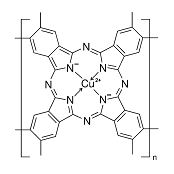
Electrochemical and nanogravimetric studies of poly(copper phthalocyanine) microparticles immobilized on gold in aqueous solutions
The paper authored by
K. Borsos and
G. Inzelt
is published in Journal of Solid State Electrochemistry (2015, vol. 19, pp. 2565–2577).
Abstract:
An electrochemical quartz crystal nanobalance has been used to study the redox behavior of poly(copper phthalocyanine) (poly(CuPc)) microparticles attached to gold. The electrodes were investigated in contact with aqueous solutions at different pH values. In acid solutions, in the pH range from 0 to 3, one pair of reduction and reoxidation waves can be detected in the potential region from 0.8 V vs. SCE to the beginning of the hydrogen evolution. Until 0.8 V, no oxidation of the poly(CuPc) sample occurs. The reduction is accompanied with a mass increase; the original mass of the surface layer is regained during reoxidation. Below pH 0, two pairs of waves appear attesting the formation of the doubly protonated poly(CuPc). A ca. -60 mV/pH dependence of the peak potentials indicates the participation of H+ ions in the redox reactions in an 1 H+/1 e- ratio in acidic and neutral solutions and the formation of 1 OH- ion/1 e- in basic electrolytes. In neutral and alkaline solutions, however, the mass changes become more complicated. In alkaline media, during electroreduction, a mass decrease occurs in the beginning of the reduction which is followed by a mass increase. In the course of reoxidation, the opposite pattern can be detected in respect of the mass changes. The peak currents show a minimum value at neutral pH. On the other hand, the mass changes are substantially higher in alkaline solutions than in acidic ones, i.e., the apparent molar mass values that can be determined are much higher, which is related to the dimerization causing a structural change and dehydration of the layer. The redox processes can be assigned to the reduction and oxidation of the Pc ring. The mass changes are related to the sorption and desorption of counterions and solvent molecules; however, coions also enter and leave the layer. Based on these observations, redox schemes are proposed.
